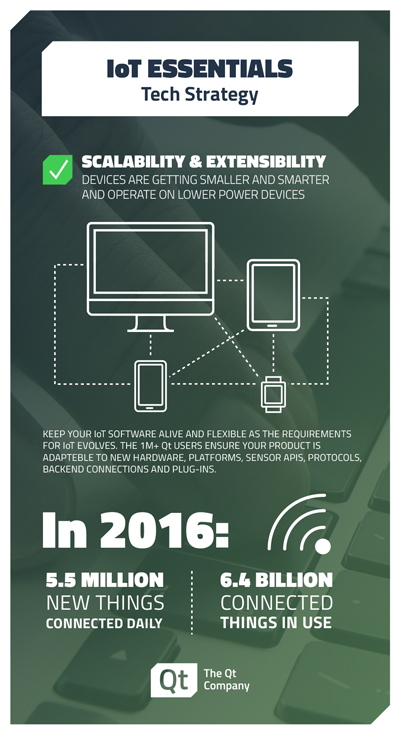Embedded Systems Are the Backbone of IoT, but It's Software That Brings It All Together
August 29, 2016 by Tuukka Ahoniemi | Comments
Smoking hot terms like Big Data and the Internet of Things or "IoT" have taken their place in conventional business lingo, and it’s practically impossible to avoid these terms — everyone has recognized what developers have seen for many years. New applications for your products, new opportunities for your offering, new customer areas are emerging, and the time to re-think how you apply connectivity, mash-ups and various sensors is going mainstream. As the business potential has started to materialize, we see that the ecosystem around IoT begins to intensify and expand, strengthening the backbone of IoT, as it shifts into high gear.
 You could argue that the Internet of Things is simply the connected embedded system re-coined. These systems are already around us and machine-to-machine (M2M) systems have been chatting to each other for decades. But in addition to just the technical capabilities between embedded devices, IoT also includes the aspect of The Omnipresent Cloud and mobile client access, shifting the way we use these connected embedded systems. And that then enables all the new IoT innovations, but also affects how we need to design these systems, especially from software perspective: Instead of creating a self-contained embedded device with an online connection, we are designing complex and extensible systems with connected sensors, embedded devices, a cloud back-end and mobile clients. *Poof* Embedded software design just became exponentially more complex.
You could argue that the Internet of Things is simply the connected embedded system re-coined. These systems are already around us and machine-to-machine (M2M) systems have been chatting to each other for decades. But in addition to just the technical capabilities between embedded devices, IoT also includes the aspect of The Omnipresent Cloud and mobile client access, shifting the way we use these connected embedded systems. And that then enables all the new IoT innovations, but also affects how we need to design these systems, especially from software perspective: Instead of creating a self-contained embedded device with an online connection, we are designing complex and extensible systems with connected sensors, embedded devices, a cloud back-end and mobile clients. *Poof* Embedded software design just became exponentially more complex.
As computers (and sensors) get smaller, smarter and connected, our everyday objects, from clothing to lavatories to cars, get more intelligent. Although hardware has center stage, it’s time to start looking at the software that will bring it all together.
Embedded Development Can Be Modern, Too
In the past ten years, there has been a tremendous leap in how software is developed. Modern software development in general seems to be about finding new ways of working even more agile, adopting new techniques quickly, abandoning non-working ones, moving rapidly forward with continuously deployed changes and near-realtime iterations in a harmonious telepathy between the customer and a self-guiding and proactive development team.
Modern software development is naturally awesome, but unfortunately, in embedded software development one can too rarely apply any of the stuff the cool kids in the web/mobile world are hyping about. Because of industry-related verification/certification requirements and especially the technical limitations of embedded cross-compilation workflow, I still hear waterfalls in the distance. At the same time, when we’re supposed to create these complex and innovative IoT things with modern touch UIs, we can’t afford to have development cycles that take weeks for each iteration of a simple UI tweak. The markets need to be reached faster! This is what we want to change with Qt—we want to make embedded development as seamless as desktop or mobile development. We want to provide one technology for all embedded and mobile platforms -- and enable rapid deployment cycles for the whole IoT system.
Qt libraries give you various UI approaches for creating a unified UX between your embedded and mobile devices. In addition, there are plenty of high-level Qt APIs for creating the engine of your IoT gateways: eg. Bluetooth LE for sensor communication and built-in JSON support for cloud communication. Qt Creator IDE works on all platforms, supports direct deployment to desktop, embedded and mobile targets and includes all the tools for designing, developing, debugging, profiling and analyzing your code. You can do rapid prototyping on your laptop and push the build to your embedded hardware or mobile device to see the changes there.
- Support multiple devices with or without screens
- Leverage your core communication libraries between a desktop interface and a mobile gadget
- Share code with other IoT developers building different parts of the ecosystem
To learn why having an embedded tool that has powerful UX capabilities can make the difference for your business: Read the whitepaper "Building the Internet of Things and How Qt Can Help".
Blog Topics:
Comments
Subscribe to our newsletter
Subscribe Newsletter
Try Qt 6.10 Now!
Download the latest release here: www.qt.io/download.
Qt 6.10 is now available, with new features and improvements for application developers and device creators.
We're Hiring
Check out all our open positions here and follow us on Instagram to see what it's like to be #QtPeople.


